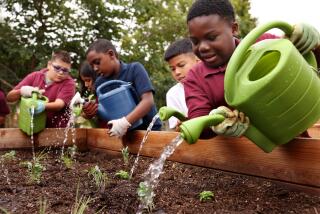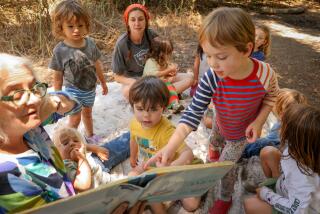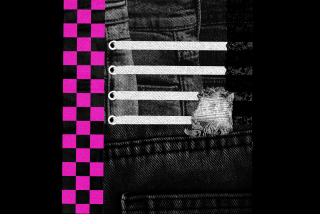Storefront school sells students on themselves : Unique project in Harlem relies on human touch to teach poor children that they can overcome adversity.
NEW YORK — It is 7:30 on a bone-chilling winter morning in East Harlem, but Ned O’Gorman is perched where he always perches at this hour, in bad weather or good. He’s on the stoop outside the Children’s Storefront on East 129th Street, waiting for the kids to arrive.
When at last they do, this gentle giant of a man in a blue watch cap, a down vest and a plaid muffler springs up and bounds down the steps to greet them.
Hugs and kisses are profusely dispensed. One little girl is hoisted into the air and told how pretty she looks in her colorful parka. Another child’s latest scrawling crayon drawing is praised: “Oh, it’s too beautiful, it’s too lovely, it’s glorious.”
It’s hard to believe that these are just kids coming to school and not long-lost relatives arriving at a family reunion.
But this daily welcoming ritual is part of O’Gorman’s unorthodox approach to education as headmaster of a unique Harlem school that he founded in an unused storefront 25 years ago.
His students, he says bluntly, are victims of some of the worst poverty and racial oppression in America. They come from families that often are racked by drugs and alcoholism. Crime and violence are an everyday part of their lives. Many would even go hungry if it were not for the two meals a day the school serves.
“These children need more than reading, writing and arithmetic,” said O’Gorman, 62, a poet, educator and former Benedictine brother. “They need a whole universe presented to them that they can live in and hope in.”
They will not find that in the typical Harlem school because public education is “knee-deep in the moral cesspool” swamping all of New York City, he insists.
At the Children’s Storefront, they will find what O’Gorman poetically depicts as a “community of healing” and what more prosaically might be described as an unusual amalgam of prep school, experimental academy and community outreach center.
The school, which occupies two row houses and two four-story brownstones, goes from preschool to eighth grade. Total enrollment is about 120 students. Although the school is private, tuition is free and no special admittance requirements are imposed. If you live in the neighborhood, you are eligible.
O’Gorman accepts virtually no government aid. Private donors, including many foundations, support the school and its annual $1.5-million operating budget. And the donors have high praise for the school and its methods.
“The Storefront’s concept of high expectations for kids is an essential ingredient in its success,” said Prudence Brown, deputy director of the Ford Foundation’s urban poverty program. “That core confidence in human potential is evident in its curriculum, in how accessible the school is and in its total commitment to the kids, many of whom were given up by public schools.”
Classroom studies stress Western classics, including Greek and Latin writers--in those languages. At the same time, students call their teachers by their first names, and there is a kind of “open classroom” easiness regarding discipline.
The human touch is fundamental and lasts long after a child has been graduated. Antoinette Williams, 27, who was one of the school’s first graduates and is now a preschool teacher herself here, says she doubts whether she would have made it through high school without O’Gorman’s help.
No subjects are taboo in classroom discussions, especially if they reflect realities with which students are familiar.
For example, while showing a class of 15 first-graders an illustrated book about gardens, O’Gorman waxed ecstatically about his plans for a school garden, but he did not shy away from adding his own bittersweet memories of a garden long ago.
“When I was a little boy and my mom and dad were drinking and fighting and not talking much, I would go out into the garden,” said O’Gorman, scion of a patrician Connecticut family. “I loved to be by myself in that garden.”
“What happened to them?” one youngster asked.
“Eventually my father got a divorce from my mother, and then my father and mother died,” he answered bluntly.
“What did they drink, beer?” asked another child.
“They didn’t drink beer. They drank gin,” O’Gorman said. “They drank liquor!”
The moral of O’Gorman’s story is one the school attempts to reinforce at every opportunity: You can overcome your background, no matter how deprived, and live a rich, full life with a love of beauty and intellect.
Most kids get the message. Victor Catano, first brought to the school by a concerned baby sitter, is now a scholarship student at New York’s prestigious Browning High School, where he excels in math and science and is a star athlete.
Some do not. Robert Cole, who was one of the few pupils ever asked to leave the school, was shot by police last year while trying to rob a store. Thirty-five crack vials were found in his pocket. He was 13.
But O’Gorman never gives up on the dream with which he first came to Harlem during the socially turbulent 1960s.
“We try to do three things here: to liberate, to teach and to heal,” he said.
More to Read
Sign up for Essential California
The most important California stories and recommendations in your inbox every morning.
You may occasionally receive promotional content from the Los Angeles Times.










